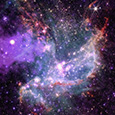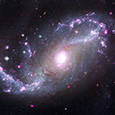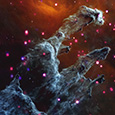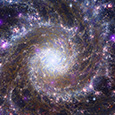NASA's Chandra, Webb Combine for Arresting Views
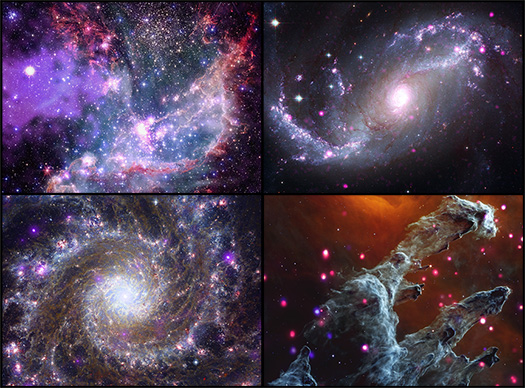
NGC 346, NGC 1672, M74 & M16
Credit: X-ray: Chandra: NASA/CXC/SAO, XMM: ESA/XMM-Newton; IR: JWST: NASA/ESA/CSA/STScI, Spitzer: NASA/JPL/CalTech; Optical: Hubble: NASA/ESA/STScI, ESO; Image Processing: L. Frattare, J. Major, N. Wolk, and K. Arcand
Four composite images deliver dazzling views from NASA's Chandra X-ray Observatory and James Webb Space Telescope of two galaxies, a nebula, and a star cluster. Each image combines Chandra's X-rays — a form of high-energy light — with infrared data from previously released Webb images, both of which are invisible to the unaided eye. Data from NASA's Hubble Space Telescope (optical light) and retired Spitzer Space Telescope (infrared), plus the European Space Agency's XMM-Newton (X-ray) and the European Southern Observatory's New Technology Telescope (optical) is also used. These cosmic wonders and details are made available by mapping the data to colors that humans can perceive.
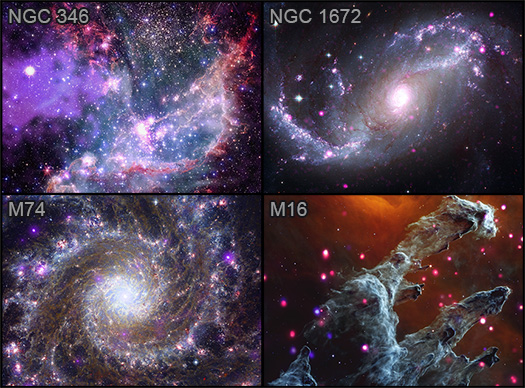
Beginning in the upper left and moving clockwise, the objects are:
NGC 346:
NGC 346 is a star cluster in a nearby galaxy, the Small Magellanic Cloud, about 200,000 light-years from Earth. Webb shows plumes and arcs of gas and dust that stars and planets use as source material during their formation. The purple cloud on the left seen with Chandra is the remains of a supernova explosion from a massive star. The Chandra data also reveals young, hot, and massive stars that send powerful winds outward from their surfaces. Additional data from Hubble and Spitzer is included, along with supporting data from XMM-Newton and ESO’s New Technology Telescope. (X-ray: purple and blue; infrared/optical: red, green, blue)
NGC 1672:
NGC 1672 is a spiral galaxy, but one that astronomers categorize as a “barred” spiral. In regions close to their centers, the arms of barred spiral galaxies are mostly in a straight band of stars across the center that encloses the core, as opposed to other spirals that have arms that twist all the way to their core. The Chandra data reveals compact objects like neutron stars or black holes pulling material from companion stars as well as the remnants of exploded stars. Additional data from Hubble (optical light) helps fill out the spiral arms with dust and gas, while Webb data shows dust and gas in the galaxy’s spiral arms. (X-ray: purple; optical: red, green, blue; infrared: red, green, blue)
M16 (Eagle Nebula):
Messier 16, also known as the Eagle Nebula, is a famous region of the sky often referred to as the “Pillars of Creation.” The Webb image shows the dark columns of gas and dust shrouding the few remaining fledgling stars just being formed. The Chandra sources, which look like dots, are young stars that give off copious amounts of X-rays. (X-ray: red, blue; infrared: red, green, blue)
M74:
Messier 74 is also a spiral galaxy — like our Milky Way — that we see face-on from our vantage point on Earth. It is about 32 million light-years away. Messier 74 is nicknamed the Phantom Galaxy because it is relatively dim, making it harder to spot with small telescopes than other galaxies in Charles Messier’s famous catalog from the 18th century. Webb outlines gas and dust in the infrared while Chandra data spotlights high-energy activity from stars at X-ray wavelengths. Hubble optical data showcases additional stars and dust along the dust lanes. (X-ray: purple; optical: orange, cyan, blue, infrared: green, yellow, red, magenta)
NASA's Marshall Space Flight Center manages the Chandra program. The Smithsonian Astrophysical Observatory's Chandra X-ray Center controls science operations from Cambridge, Massachusetts, and flight operations from Burlington, Massachusetts.
The James Webb Space Telescope is the world’s premier space science observatory. Webb will solve mysteries in our solar system, look beyond to distant worlds around other stars, and probe the mysterious structures and origins of our universe and our place in it. Webb is an international program led by NASA with its partners, ESA (European Space Agency) and the Canadian Space Agency.
- Log in to post comments

